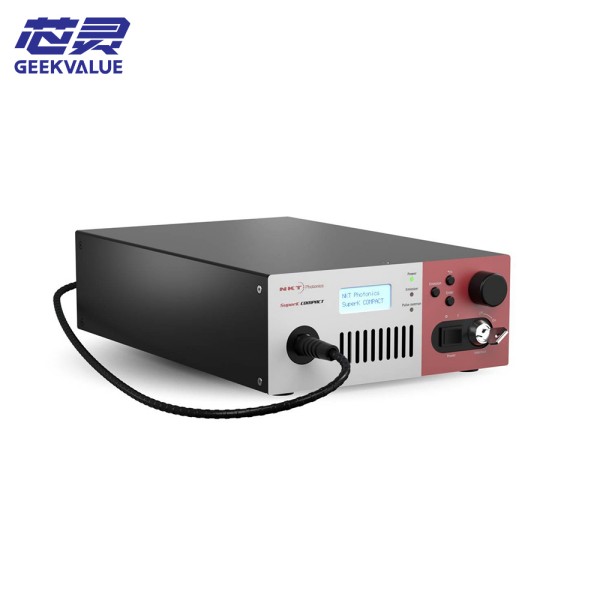SuperK COMPACT ir augstas veiktspējas superkontinuuma baltās gaismas lāzers, ko izlaida NKT Photonics, kas ir nozarē vadošais plaša spektra gaismas avota risinājums. Šī sērija integrē laboratorijas līmeņa spektrālo veiktspēju rūpnieciski pielietojamās miniaturizētās sistēmās, galvenokārt orientējoties uz zinātnēm par dzīvību, rūpniecisko noteikšanu un spektrālo analīzi.
2. Tehniskie pamatparametri
1. Spektrālie raksturlielumi
Parametri Darbības rādītāji
Spektra diapazons 450-2400 nm (aptver redzams līdz tuvajam infrasarkanajam staram)
Spektrālās jaudas blīvums > 1 mW/nm (pie 500–800 nm)
Spektra plakanums ±3 dB (tipiskā vērtība)
Izejas jauda Līdz 8W (atkarībā no viļņu garuma diapazona)
2. Gaismas avota veiktspēja
Impulsu raksturlielumi:
Atkārtošanās frekvence: 20-80 MHz regulējama
Impulsa platums: <100 ps
Telpiskās īpašības:
Sijas kvalitāte: M²<1,3
Šķiedru savienojums: viena režīma šķiedras izeja (pēc izvēles SMF-28 vai HI1060)
3. Sistēmas specifikācijas
Izmēri: 320 x 280 x 115 mm (galddatora modelis)
Svars: <7 kg
Dzesēšanas metode: gaisa dzesēšana (nav nepieciešama ārēja ūdens dzesēšana)
3. Tehnisko priekšrocību analīze
1. Patentēta fotonisko kristālšķiedru tehnoloģija
Uzlabots nelineārais efekts: NKT patentētās LMA-PCF šķiedras izmantošana, lai panāktu efektīvu spektra paplašināšanu
Bez režīma lēciena: izvairieties no tradicionālo superkontinuuma gaismas avotu modālās nestabilitātes problēmas
2. Inteliģenta vadības sistēma
Reāllaika jaudas stabilitāte: iebūvēta atgriezeniskās saites ķēde (jaudas svārstības <1% RMS)
Tālvadības pults interfeiss:
USB/RS-232 standarta interfeiss
Nodrošiniet LabVIEW draiveri un SDK izstrādes komplektu
3. Moduļu dizains
Nomaināms filtra modulis:
Izvēles vienas joslas izeja (piemēram, 500–600 nm)
Atbalsta daudzkanālu spektroskopiju (līdz 8 neatkarīgi kontrolētiem kanāliem)
Paplašināšanas ports:
Ārējā sprūda ieeja (sinhronizācijas precizitāte <1ns)
Jaudas uzraudzības izeja
IV. Tipiski pielietojuma scenāriji
1. Dzīvības zinātnes pētījumi
Daudzfotonu mikroskopija:
Vairāku fluorescējošu marķieru vienlaicīga ierosināšana
Dziļo audu attēlveidošana (piemēram, peles smadzeņu šķēles)
Plūsmas citometrija:
Ļoti jutīga retu šūnu apakšpopulāciju noteikšana
2. Rūpnieciskā pārbaude
Pusvadītāju defektu noteikšana:
Plaša spektra apgaismojums uzlabo defektu kontrastu
Attiecas uz vafelēm un iepakotām ierīcēm
Materiāla sastāva analīze:
Ramana spektroskopijas uzlabots gaismas avots
Plastmasas/narkotiku ātra skrīnings
3. Optiskā metroloģija
Optiskā koherences tomogrāfija (OCT):
Aksiālā izšķirtspēja <2 μm
Oftalmoloģijas/dermatoloģijas attēlveidošana
Spektrālā kalibrēšana:
Astronomiskā teleskopa viļņa garuma etalons
V. Sistēmas sastāvs un konfigurācija
1. Standarta konfigurācija
Uzņēmēja bloks (ieskaitot sūkņa lāzeru un nelineāro šķiedru)
Barošanas modulis (100–240 V maiņstrāvas adaptīvs)
Viena režīma izvades šķiedra (1,5 metrus garš, FC/APC savienotājs)
Vadības programmatūra (SuperK Keeper)
2. Izvēles piederumi
Piederuma tips Funkcionālais apraksts
Noskaņojams filtra modulis. Joslas platums 10-50nm nepārtraukti regulējams
Daudzkanālu staru sadalītājs Līdz 8 viļņu garumiem neatkarīga izeja
Jaudas stabilizācijas modulis Slēgtā cikla vadības precizitāte ±0,5%
Šķiedru savienotājs Pielāgojiet mikroskopa/spektrometra saskarnei
VI. Salīdzināšanas priekšrocības ar konkurentiem
Salīdzināšanas vienumi SuperK COMPACT Konkurents A Konkurents B
Spektra diapazons 450-2400nm 470-2200nm 500-2000nm
Jaudas stabilitāte <1% RMS <2% RMS <3% RMS
Izmērs 0,01 m³ 0,03 m³ 0,02 m³
Palaišanas laiks <15 minūtes > 30 minūtes > 60 minūtes
VII. Ekspluatācija un apkope
Ātrā palaišana: iesildīšanās laiks <15 minūtes (tradicionālajam superkontinuuma gaismas avotam nepieciešama 1 stunda +)
Inteliģenta diagnoze:
Šķiedru statusa uzraudzība reāllaikā
Automātiska jaudas samazināšanas aizsardzība
Apkopes cikls:
Filtru ieteicams nomainīt ik pēc 5000 stundām
Šķiedras kalpošanas laiks > 20 000 stundas
VIII. Atlases ieteikumi
Pamatmodelis: piemērots parastajiem laboratorijas lietojumiem (piemēram, fluorescences attēlveidošanai)
Rūpnieciskā pastiprinājuma versija: ar triecienizturīgu dizainu un IP50 aizsardzību (piemērojams ražošanas līnijas videi)
Pielāgota viļņa garuma versija: var norādīt noteiktu joslas optimizāciju (piemēram, 600-800 nm)
SuperK Apvienojot plašu spektra pārklājumu ar miniaturizētu dizainu, COMPACT no jauna definē superkontinuuma gaismas avotu rūpnieciskās pielietojamības standartu un ir īpaši piemērots augstākās klases zinātniskiem pētījumiem un rūpnieciskiem scenārijiem, kuriem nepieciešama vairāku viļņu garumu paralēlā noteikšana. Tā lieliskā stabilitāte padara to par ideālu gaismas avotu OCT sistēmām un spektrālās analīzes veikšanai.



